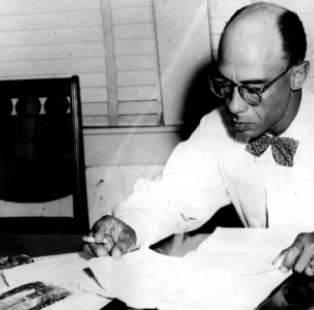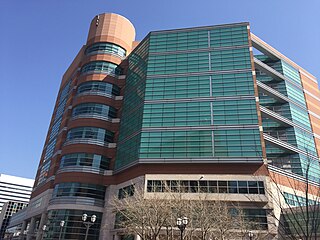
Travis County is located in Central Texas. As of the 2020 census, the population was 1,290,188. It is the fifth-most populous county in Texas. Its county seat and most populous city is Austin, the capital of Texas. The county was established in 1840 and is named in honor of William Barret Travis, the commander of the Republic of Texas forces at the Battle of the Alamo. Travis County is part of the Austin–Round Rock–Georgetown Metropolitan Statistical Area. It is located along the Balcones Fault, the boundary between the Edwards Plateau to the west and the Blackland Prairie to the east.
Sweatt v. Painter, 339 U.S. 629 (1950), was a U.S. Supreme Court case that successfully challenged the "separate but equal" doctrine of racial segregation established by the 1896 case Plessy v. Ferguson. The case was influential in the landmark case of Brown v. Board of Education four years later.

A super-maximum security (supermax) or administrative maximum (ADX) prison is a "control-unit" prison, or a unit within prisons, which represents the most secure level of custody in the prison systems of certain countries.

Heman Marion Sweatt was an African-American civil rights activist who confronted Jim Crow laws. He is best known for the Sweatt v. Painter lawsuit, which challenged the "separate but equal" doctrine and was one of the earliest of the events that led to the desegregation of American higher education.

The Texas Department of Criminal Justice (TDCJ) is a department of the government of the U.S. state of Texas. The TDCJ is responsible for statewide criminal justice for adult offenders, including managing offenders in state prisons, state jails, and private correctional facilities, funding and certain oversight of community supervision, and supervision of offenders released from prison on parole or mandatory supervision. The TDCJ operates the largest prison system in the United States.
Margo Frasier is an American lawyer and former sheriff. She was sheriff of Travis County, Texas from 1997 through 2004.

The St. Louis County Jail is located inside the Buzz Westfall Justice Center in Clayton, Missouri at 100 South Central Avenue, about eight miles (13 km) from downtown St. Louis. The holding capacity of the facility is 1,400 male and female inmates. The St. Louis County Jail is a direct-supervision facility that detains adults and juveniles being tried as adults who are awaiting trial or serving county sentences and is the only jail in Missouri that holds an accreditation known as the ALDF from the American Correctional Association (ACA). Opened in March 1998, the center replaced both the jail in the 1949 St. Louis County Courthouse building and the Adult Correctional Building in Chesterfield, Missouri. The center was rededicated the "Buzz Westfall Justice Center" in 2004.

Downtown Austin is the central business district of Austin, Texas, United States. The area of the district is bound by Lamar Boulevard to the west, Martin Luther King Jr. Boulevard to the north, Interstate 35 to the east, and Lady Bird Lake to the south.

The Cook County Jail, located on 96 acres in South Lawndale, Chicago, Illinois, is operated by the Sheriff of Cook County. It is sometimes referred to as California or Hotel California, as its address is on California Avenue. A city jail has existed on this site since after the Great Chicago Fire of 1871, but major County prisoners were not generally collocated here until closure of the old Hubbard Street Criminal Court Building and jail in 1929. Since then, a 1920s neoclassical and art deco courthouse for the criminal division of the Cook County Circuit Court has operated at the South Lawndale complex.

The Baraga County Courthouse is the seat of government for Baraga County, Michigan, located at 16 North Third Street in L'Anse. The courthouse and adjacent annex are designated a Michigan State Historic Site. As of 2012, the courthouse operates courtrooms for the 12th Circuit Court, 97th District Court, and Baraga County Probate Court.

The government of Harris County, Texas maintains its main jail complex in Downtown Houston, Texas. The complex, operated by the Harris County Sheriff's Office (HCSO), lies in the peninsula formed by the Buffalo Bayou in northern Downtown. While most of the complex is based on county jails serving Harris County, Joe Kegans State Jail is also located within the complex. The Harris County District Court is located just next to the jail complex.

The Austin United States Courthouse is a historic former federal courthouse in downtown Austin, Texas. Built between 1935 and 1936, the building exemplifies Depression-era Moderne architecture, while Art Moderne and Art Deco finishes characterize the interior. It housed the Austin division of the United States District Court for the Western District of Texas and other judicial offices until 2012, when a new federal courthouse building was completed. Since 2016 the building has been owned by Travis County, and it has housed the county probate courts since 2020. The structure was added to the National Register of Historic Places in 2001.

The Austin United States Courthouse is a federal courthouse in downtown Austin, Texas. Built between 2009 and 2012, the building houses the Austin division of the United States District Court for the Western District of Texas and other federal judicial offices. It replaced the 1936 Austin U.S. Courthouse, which has since been transferred to Travis County to hold county judicial space.

John W. Brady was an American lawyer. He served as a county attorney from 1902 to 1910, the assistant attorney general for the state, and a judge on the Texas Third Court of Civil Appeals. In 1929 he was convicted of murder, and sentenced to three years in prison.

William Paul Brady was an American lawyer. From 1909 to around 1914, he served as the first district attorney for Texas' 70th judicial district, and from 1917 to 1919 he was the judge for the newly created El Paso County Court at Law. Brady prosecuted several high-profile murder cases as a district attorney, including of Agnes Orner, and in a death-penalty case that has since been termed a "legal lynching" of a Mexican boy charged with killing a white woman.

The Little Campus is a historic district and part of the University of Texas at Austin campus in Austin, Texas. Originally built in 1856 as the Texas Asylum for the Blind, the complex was used for a variety of purposes through the late nineteenth and early twentieth centuries. It was acquired by the University of Texas after World War I and listed on the National Register of Historic Places in 1974.
Rodney Rodell Reed is an American death row inmate who was convicted on May 18, 1998, by a Bastrop County District Court jury for the April 1996 abduction, rape, and murder of Stacey Stites, a 19-year-old resident of Giddings, Texas.
Lyle Richard Brummett is an American serial killer who raped and killed three women in Texas from 1975 to 1976, two with the help of accomplice Allen Ladd Woody. Charged with two of the killings in exchange for testifying against Woody, Brummett had one of the murder charges dropped and was sentenced to life imprisonment.
Willie Roy Jenkins is an American murderer, rapist and suspected serial killer who was linked via DNA to a 1975 rape-murder committed in San Marcos, Texas, while he was imprisoned for four rapes committed in California during the 1970s. Convicted and sentenced to death for this crime, he has since been proposed as a suspect in three additional murders, but so far has not been charged with any of them.
The Travis County Corrections Bureau encompasses two correctional facilities managed by the Travis County Sheriff's Office in Travis County, Texas: the Travis County Jail, a central booking facility in downtown Austin, and the Travis County Correctional Complex in Del Valle.

















